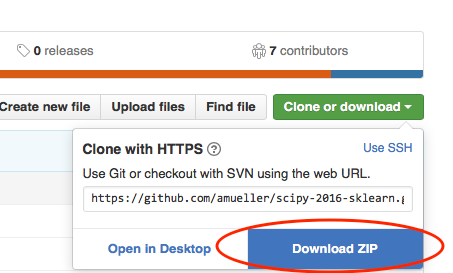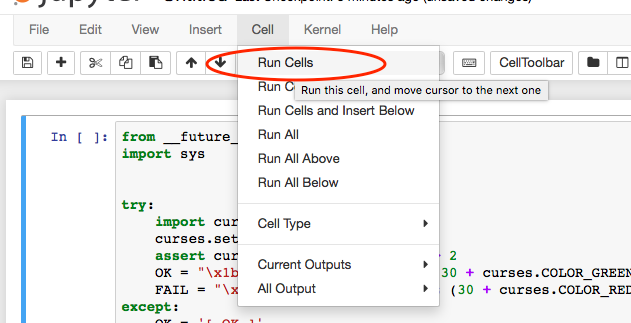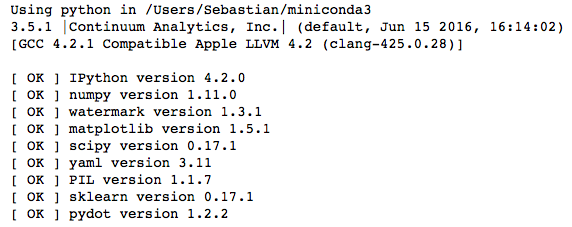Based on the SciPy 2015 tutorial by Kyle Kastner and Andreas Mueller.
- Sebastian Raschka @rasbt - Michigan State University, Computational Biology; Book: Python Machine Learning
- Andreas Mueller @amuellerml - NYU Center for Data Science; Book: Introduction to Machine Learning with Python
The video recording of the tutorial is now available via YouTube:
This repository will contain the teaching material and other info associated with our scikit-learn tutorial at SciPy 2016 held July 11-17 in Austin, Texas.
Parts 1 to 5 make up the morning session, while parts 6 to 9 will be presented in the afternoon.
The 2-part tutorial will be held on Tuesday, July 12, 2016.
- Parts 1 to 5: 8:00 AM - 12:00 PM (Room 105)
- Parts 6 to 9: 1:30 PM - 5:30 PM (Room 105)
(You can find the full SciPy 2016 tutorial schedule here.)
If you have a GitHub account, it is probably most convenient if you fork the GitHub repository. If you don’t have an GitHub account, you can download the repository as a .zip file by heading over to the GitHub repository (https://github.com/amueller/scipy-2016-sklearn) in your browser and click the green “Download” button in the upper right.
Please note that we may add and improve the material until shortly before the tutorial session, and we recommend you to update your copy of the materials one day before the tutorials. If you have an GitHub account and forked/cloned the repository via GitHub, you can sync your existing fork with via the following commands:
git remote add upstream https://github.com/amueller/scipy-2016-sklearn.git
git fetch upstream
git checkout master merge upstream/master
If you don’t have a GitHub account, you may have to re-download the .zip archive from GitHub.
This tutorial will require recent installations of
The last one is important, you should be able to type:
jupyter notebook
in your terminal window and see the notebook panel load in your web browser. Try opening and running a notebook from the material to see check that it works.
For users who do not yet have these packages installed, a relatively painless way to install all the requirements is to use a Python distribution such as Anaconda CE, which includes the most relevant Python packages for science, math, engineering, and data analysis; Anaconda can be downloaded and installed for free including commercial use and redistribution. The code examples in this tutorial should be compatible to Python 2.7, Python 3.4, and Python 3.5.
After obtaining the material, we strongly recommend you to open and execute the Jupyter Notebook
jupter notebook check_env.ipynb that is located at the top level of this repository. Inside the repository, you can open the notebook
by executing
jupyter notebook check_env.ipynbinside this repository. Inside the Notebook, you can run the code cell by clicking on the "Run Cells" button as illustrated in the figure below:
Finally, if your environment satisfies the requirements for the tutorials, the executed code cell will produce an output message as shown below:
Although not required, we also recommend you to update the required Python packages to their latest versions to ensure best compatibility with the teaching material. Please upgrade already installed packages by executing
pip install [package-name] --upgrade- or
conda update [package-name]
The data for this tutorial is not included in the repository. We will be using several data sets during the tutorial: most are built-in to scikit-learn, which includes code that automatically downloads and caches these data.
Because the wireless network
at conferences can often be spotty, it would be a good idea to download these
data sets before arriving at the conference.
Please run python fetch_data.py to download all necessary data beforehand.
The download size of the data files are approx. 280 MB, and after fetch_data.py
extracted the data on your disk, the ./notebook/dataset folder will take 480 MB
of your local solid state or hard drive.
- 01 Introduction to machine learning with sample applications, Supervised and Unsupervised learning [[view](notebooks/01\ Introduction\ to\ Machine\ Learning.ipynb)]
- 02 Scientific Computing Tools for Python: NumPy, SciPy, and matplotlib [[view](notebooks/02\ Scientific\ Computing\ Tools\ in\ Python.ipynb)]
- 03 Data formats, preparation, and representation [[view](notebooks/03\ Data\ Representation\ for\ Machine\ Learning.ipynb)]
- 04 Supervised learning: Training and test data [[view](notebooks/04\ Training\ and\ Testing\ Data.ipynb)]
- 05 Supervised learning: Estimators for classification [[view](notebooks/05\ Supervised\ Learning\ -\ Classification.ipynb)]
- 06 Supervised learning: Estimators for regression analysis [[view](notebooks/06\ Supervised\ Learning\ -\ Regression.ipynb)]
- 07 Unsupervised learning: Unsupervised Transformers [[view](notebooks/07\ Unsupervised\ Learning\ -\ Transformations\ and\ Dimensionality\ Reduction.ipynb)]
- 08 Unsupervised learning: Clustering [[view](notebooks/08\ Unsupervised\ Learning\ -\ Clustering.ipynb)]
- 09 The scikit-learn estimator interface [[view](notebooks/09\ Review\ of\ Scikit-learn\ API.ipynb)]
- 10 Preparing a real-world dataset (titanic) [[view](notebooks/10\ Case\ Study\ -\ Titanic\ Survival.ipynb)]
- 11 Working with text data via the bag-of-words model [[view](notebooks/11\ Text\ Feature\ Extraction.ipynb)]
- 12 Application: IMDb Movie Review Sentiment Analysis [[view](notebooks/12\ Case\ Study\ -\ SMS\ Spam\ Detection.ipynb)]
- 13 Cross-Validation [[view](notebooks/13\ Cross\ Validation.ipynb)]
- 14 Model complexity and grid search for adjusting hyperparameters [[view](notebooks/14\ Model\ Complexity\ and\ GridSearchCV.ipynb)]
- 15 Scikit-learn Pipelines [[view](notebooks/15\ Pipelining\ Estimators.ipynb)]
- 16 Supervised learning: Performance metrics for classification [[view](notebooks/16\ Performance\ metrics\ and\ Model\ Evaluation.ipynb)]
- 17 Supervised learning: Linear Models [[view](notebooks/17\ In\ Depth\ -\ Linear\ Models.ipynb)]
- 18 Supervised learning: Support Vector Machines [[view](notebooks/18\ In\ Depth\ -\ Support\ Vector\ Machines.ipynb)]
- 19 Supervised learning: Decision trees and random forests, and ensemble methods [[view](notebooks/19\ In\ Depth\ -\ Trees\ and\ Forests.ipynb)]
- 20 Supervised learning: feature selection [[view](notebooks/20\ Feature\ Selection.ipynb)]
- 21 Unsupervised learning: Hierarchical and density-based clustering algorithms [[view](notebooks/21\ Unsupervised\ learning\ -\ Hierarchical\ and\ density-based\ clustering\ algorithms.ipynb)]
- 22 Unsupervised learning: Non-linear dimensionality reduction [[view](notebooks/22\ Unsupervised\ learning\ -\ Non-linear\ dimensionality\ reduction.ipynb)]
- 23 Supervised learning: Out-of-core learning [[view](notebooks/23\ Out-of-core\ Learning\ Large\ Scale\ Text\ Classification.ipynb)]


